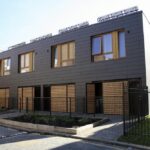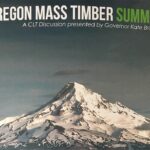Our coverage of Portland’s Mass Timber conference week continues, with a recap of a panel discussion on the environmental impacts of cross-laminated timber.
Organizers of this week’s International Mass Timber Conference in Portland devoted a whole track of their three-day event to environmental and sustainability aspects of the mass timber sector — an indication of how important sustainability is to the tall timber building brand.
Manufacturing of cross laminated timber, or CLT — the product used to construct tall timber buildings — has the potential to revitalize the timber sector and the rural communities in Oregon that have fallen on hard times because of the widespread closure of timber mills across the state.
But experts concede the environmental benefits of CLT are complex and difficult to measure.
Structural engineers look at the lifecycle emissions of CLT when assessing the environmental impact of tall timber buildings. The lifecycle analysis takes account of the greenhouse gas emissions from the harvesting of the wood, through the manufacturing and construction of tall timber buildings, to their eventual demolition.
When taking this cradle-to-grave assessment, the environmental benefits of CLT are not clear cut (pardon the pun).
For one, careful forest management is a crucial part of ensuring the sustainability factor. Replanting trees after harvest is a critical part of this management. But there are also other considerations.
Brent Davies, a vice president of forests and ecosystem services at Ecotrust, said during a panel discussion at the mass timber conference that sustainability goals embodied in CLT branding depend on practices certified under the Forest Stewardship Council.
These practices include ensuring trees on steep slopes are not chopped down, that there is enough shade left to keep the water cold in streams, and that the maximum size of trees clear cut is limited to 40 acres.
The issue is that many forests, including federally owned forests and land managed by the Bureau of Land Management, are not certified under the Forest Stewardship Council.
“Industrial forestry stores less carbon and produces less timber than forests management under FSC criteria,” said Davies.
RELATED STORY: ‘MORE MANUFACTURERS NEEDED’ TO JUMPSTART MASS TIMBER INDUSTRY
Transportation is another source of emissions that should be factored into CLT sustainability claims. The Pacific Northwest is a large source of timber for CLT, but a lot of the tall timber buildings will be built outside of the region. This will require the product to be shipped across the U.S. and overseas.
Lauren Wingo, structural engineer at design and consulting firm ARUP, said the wood for tall timber buildings on the U.S. east coast would have to be sourced from Canada to cut down transportation emissions necessary to meet sustainability goals.
Another aspect of CLT’s lifecycle emissions that are hard to measure is the end of life of the buildings. CLT construction can last up to 100 years, meaning engineers will not be around to measure the CO2 emitted when the buildings are demolished.
Despite the drawbacks, numerous studies show tall timber buildings sequester more carbon than concrete buildings.
They also have the potential to stimulate better management of forests and reduce the risk of wildfire, said Davies. She cited the results of a study that shows 40% of federally owned acres would see a large reduction in fire hazard through the thinning of small diameter trees used for the manufacturing of CLT.
For some, these environmental benefits, as well as the social and economic advantages of the mass timber construction, outweigh the grayness associated with the sustainability claims made by CLT supporters.
Mass timber products are proven to be a solution to the construction of environmentally sound buildings, but in some cases they may turn out to not be the only solution.






